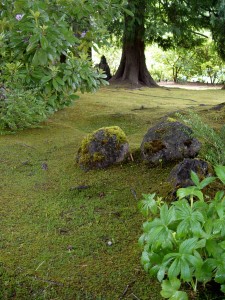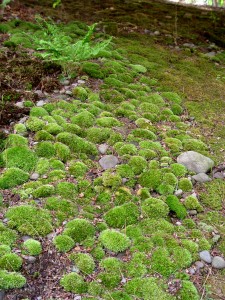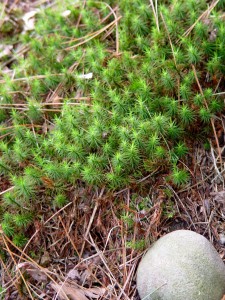Should You Kill Moss?
September 19th, 2011
When most people see moss — especially in their prized lawn — the first instinct is to kill it.
And plenty of gardeners head to the store in search of chemicals to “de–moss” their landscape, particularly in cloudy, rainy seasons when moss thrives.
Add acidy soil and you’ve got the perfect recipe for an invasion of this creeping, green-carpet-like growth.
But while the mainstream seeks to kill moss, a growing number of gardeners not only is deciding to live with it but to actually encourage it and plant it.
Some trend-watchers point to moss as one of gardening’s hot new trends — one that fits into the larger movement of trying to work with nature instead of against her.
That’s what Dave Benner did some 40 years ago when he and his wife moved to a 2-acre heavily wooded lot near the Delaware River in Bucks County.
The Benners originally envisioned a lush shade garden. But humongous tree roots, wall-to-wall weeds, rampant deer and horribly acidy and clayish soil quickly dashed that dream.
Benner, then a Delaware Valley College horticulture professor, managed to clear some of the land that first year. By early the next spring, a thin, green film magically appeared, as if someone had spray-painted the ground green (which wouldn’t have been a bad idea in that nightmare of a garden site).
Benner recognized the film as moss “protonema,” a thready growth that’s the forerunner of the moss clumps most people know.
Rather than spray it into oblivion, Benner went with the flow and accepted nature’s landscaping tip.
He spread sulfur to further acidify the ground and dug out what little bits of grass and other vegetation remained.
“By the end of the next summer, the moss had taken over everywhere, and there was no grass on our 2 acres,” Benner says in his moss handbook “Gardening with Moss.”
In the years since, this mossy pioneer has cultivated moss, ferns and native shade-loving wildflowers for a peaceful, low-maintenance landscape that’s been featured in numerous publications.
The Benners also cultivated a son, Al, who recently opened one of the nation’s first “moss farms” near Honesdale in the Pocono Mountains. This 54-acre mostly wooded, hilly tract is producing sheets of four types of moss that’s available by mail-order or Internet to home gardeners. (Moss and Dave Benner’s $18 handbook are both available through http://www.mossacres.com or toll-free 1-866-GET-MOSS.)
Al Benner says he believes a big part of moss’s new appeal has to do with Americans seeking a peaceful, quiet, relaxing environment.
“There’s something about moss and rocks and ferns,” he says. “That sort of look and feel takes people to a different place.”
He also traces the trend to our increased interest in Asian-style gardens and water gardens.
Moss has long been revered in the Orient, and moss is a natural around a shady water garden.
Stone walls and pavers also are big lately, and moss is one of the few living things that not only will grow between stones but ON them.
Yet other gardeners are using moss in shady labyrinths (another trend), as a covering for energy-saving “green roofs” (an emerging trend), for erosion control along stream banks and as a tough but lush ground covering for indoor water gardens, dish gardens, terrariums and bonsai.
Like Dave Benner, a few adventurous souls are ditching their feeble, sunlight-starved lawns in favor of a shady moss carpet.
“A lot of people are building homes in the woods, and they’re finding you just can’t get a good lawn going in that kind of site,” says Al Benner.
With patience, moss will happen if you give it the right conditions — namely shade, acidy soil and ample moisture. Moss spores (the mossy equivalent of seeds) will blow in and colonize bare, shady, acidy, damp areas, usually within a year or two. (See below for details on moss starting and care.)
A quicker way is to lay sheets of moss, much like laying grass sod instead of seeding a new lawn. That’s where Moss Acres comes in.
Jack Olson, Moss Acres’ general manager, says one of the nice things about moss is that once you dry it, it’ll keep practically forever. Once it’s laid out and watered, it comes back to life within hours — or less.
“I’ve been kind of shocked at how many people are interested in moss,” said Olson. “There’s been a demand for it but not a good supply.”
To grow moss, Olson and crew make a slurry in 30-gallon tanks using water, sulfur, a polymer gel and clumps of live moss.
“We agitate it, let it stand for an hour and spray it on bare soil,” Olson says. “In about five months, it’s starting to spread. In a year’s time, it’s filled in pretty nicely.”
Moss Acres also rescues moss from building sites that otherwise would’ve been bulldozed.
Olson says the farm also is rolling out displays and packages for garden centers to sell to their retail customers.
He says moss offers a lot of virtues near and dear to most gardeners’ hearts, such as:
* It needs no mowing, pruning or fertilizing.
* Deer and rabbits don’t eat it.
* It’s very long-lived and grows on the worst of soils, including solid rock.
* It stays green in winter.
* And, it’s tolerant of moderate foot traffic (high heels and soccer games are bad news).
On the down side, figure on picking out weeds early on until the moss thickens in.
After that, leaves must be cleared off moss each fall so they don’t mat down and rot out the moss. The Benners suggest using plastic netting… lay it over the moss just before the leaves start falling, then roll it up — leaves and all — at the end of fall. Or blow leaves off with a leaf–blower or gently rake them off.
It also helps to pick a naturally damp spot. Moss will survive in dry spots, but it’ll periodically go dormant and lose its green color until moisture returns.
Although moss is seldom bothered by bugs or diseases, patches sometimes die out from fungal infection. Birds also occasionally lift up patches of moss in search of grubs and bugs. (Just tamp it back down or protect with netting.)
Given the right setting, moss may make a lot more sense than grass or even groundcover plantings. A lot of times, nature is trying to tell us where those settings are.
So next time you see moss, consider this: If you can’t beat it, plant it.
Sidebar 1
Here’s how to grow and care for moss:
* The ideal site is damp, shady and with acidy soil. Underneath beech, oak, maple and other leaf-dropping shade trees is one good site.
* To plant, remove grass and other vegetation (avoid weed-killers) and acidify soil with sulfur or aluminum sulfate. An ideal soil pH is 5 to 5.5 or lower. A soil test will tell the current level and how much sulfur is needed to lower the pH to the target level.
* Moss eventually will appear if the soil is kept damp. Speed the process by blending 1 cup of buttermilk and 1 handful of moss in a blender, then pouring the mix over the bare ground. (Blending together 1 can of beer, 1 teaspoon of sugar and 1 handful of moss also will work.)
* Even faster is laying sheets of dried moss, then watering. One Pennsylvania source is Moss Acres, http://www.mossacres.com or toll-free 1-866-GET-MOSS.
* Clear moss of leaves every fall to prevent them from smothering and rotting the moss. Avoid planting moss under evergreens, which constantly drop needles that can rot moss.
* In dry weather, occasionally water moss if you want to keep it green.
— Source: “Gardening with Moss” by David E. Benner
Sidebar 2
Four of the best mosses for landscape use in central Pennsylvania:
* Cushion moss (Leucobryum glaucum). Very short, light green and grows in low, mounded clumps.
* Haircap moss (Polytrichum commune). Grows about 3 inches tall and has a needled evergreen look. More sun-tolerant than most.
* Rock cap moss (Dicranum flagellare). Short mat-former that looks like a green toupee. Ideal for growing on rocks.
* Fern moss (Thuidium delicatulum). Medium green and grows in a short mat with a ferny appearance. Least expensive.










